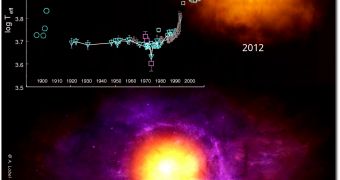A star lasts several billions of years, so observing its evolution is tricky, in the span of a human life most stars don't change at all. Thankfully, with so many stars to choose from, astronomers have a chance of catching one at every evolutionary step.
And now, astronomers from six European studies have published a report on a very particular moment in the life of a hypergiant star, the biggest and most luminous stars found so far, the Yellow Hypergiant phase.
There are very little stars like this, they occupy the stage known as the "Yellow Evolutionary Void" in the Hertzsprung-Russell diagram.
It's called that because few known stars are in this temperature range, even though current models predict that hypergiant will go through a phase like this.
The new study shows exactly why there are so few stars like this, confirming previous expectations. The study shows that this period is very unstable and incredibly short, on the time scale of a star.
Astronomers started studying HR 8752, a hypergiant in the Cassiopeia constellation, that is 250,000 times brighter than our sun. For the most part of the last century it was stable, staying at around 5,000 degrees Celsius surface temperature.
But starting around 1985, the star started heating up dramatically. In the two decades the study covers, it went from 5,000 C to 8,000 C.
In that same time, it lost a tremendous amount of mass and its radius went from about 750 times that of the sun to about 450 times the sun.
The scientists found that during this phase the "pressure" inside begins to push the atmosphere outward overcoming the gravitational pull of the star.
This leads to a huge drop in mass and a reduction in radius, but also a heating up of the star, as the remaining mass gets compacted.

 14 DAY TRIAL //
14 DAY TRIAL //